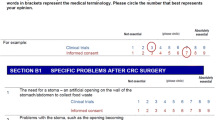Abstract
PURPOSE: Clinicians often make decisions for their patients, despite evidence that suggests that correspondence between patient and clinician decision making is poor. The management of colorectal cancer presents difficult decisions because the impact of treatment on quality of life might overshadow its survival efficacy. This study investigated whether patients are able to trade survival for quality of life as a means to express their preference for treatment options and to compare their preferences with those expressed by clinicians. METHODS: Patients undergoing curative surgery for colorectal cancer were interviewed postoperatively to elicit their preferences in four hypothetical treatment scenarios. A questionnaire was mailed to all Australian colorectal surgeons and medical oncologists that asked them to respond as if they themselves were patients. RESULTS: One hundred patients (91 percent), 43 colorectal surgeons (77 percent), and 103 medical oncologists (50 percent) participated. In all four scenarios, patients were able to trade survival for quality of life. Patients’ responses varied between scenarios, both in willingness to trade and the average amount traded. There were significant differences between patients and clinicians. Clinicians were more willing than patients to trade survival to avoid a permanent colostomy in favor of chemoradiotherapy. Patients’ strongest preference was to avoid chemotherapy, more than to avoid a permanent colostomy. CONCLUSIONS: Patients are able to trade survival as a measure of preference for quality of life and can do so differentially between treatment scenarios. Patients’ preferences do not always accord with those of clinicians. Unless patients’ preferences are explicitly sought and incorporated into clinical decision making, patients may not receive the treatment that is best for them.
Similar content being viewed by others
References
WJ MacKillop GK Ward B O’Sullivan (1986) ArticleTitleThe use of expert surrogates to evaluate clinical trials in non-small cell lung cancer Br J Cancer 54 661–667
MJ Moore B O’Sullivan IF Tannock (1988) ArticleTitleHow expert physicians would wish to be treated if they had genitourinary cancer J Clin Oncol 6 1736–1745
MJ Solomon A Laxamana L Devore RS McLeod (1994) ArticleTitleRandomized controlled trials in surgery Surgery 115 707–712
KM Taylor RG Margolese CL Soskolne (1984) ArticleTitlePhysicians’ reasons for not entering eligible patients in a randomized control trial of surgery for breast cancer N Engl J Med 310 1363–1367
MJ Solomon RS Mcleod (1995) ArticleTitleShould we be performing more randomized controlled trials evaluating surgical operations? Surgery 118 459–467
M Gattellari JE Ward MJ Solomon (2001) ArticleTitleRandomized, controlled trials in surgery Dis Colon Rectum 44 1413–1420
JE Till HJ Sutherland EM Meslin (1992) ArticleTitleIs there a role for preference assessments in research on quality of life in oncology? Qual Life Res 1 31–40
A Fagerlin PH Ditto JH Danks RM Houts WD Smucker (2001) ArticleTitleProjection in surrogate decisions about life-sustaining medical treatments Health Psychol 20 166–175
KE Covinsky JD Fuller K Yaffe et al. (2000) ArticleTitleCommunication and decision-making in seriously ill patients: findings of the SUPPORT project. The Study to Understand Prognoses and Preferences for Outcomes and Risks of Treatments J Am Geriatr Soc 48 187–193
C Kennelly A Bowling (2001) ArticleTitleSuffering in deference Qual Health Care 10 23–28
A Robinson R Thomson (2001) ArticleTitleVariability in patient preferences for participating in medical decision making Qual Health Care 10 34–38
HA Llewellyn-Thomas DC Naylor MM Cohen AS Basinski LE Ferris JI Williams (1992) ArticleTitleStudying patients preferences in health care decision making. Health Services Research Group Can Med Assoc J 147 859–864
VA Palda HA Llewellyn-Thomas RG Mackenzie KI Pritchard CD Naylor (1997) ArticleTitleBreast cancer patients’ attitudes about rationing postlumpectomy radiation therapy J Clin Oncol 15 3192–3200
HA Llewellyn-Thomas HJ Sutherland A Ciampi J Etezadi-Amoli NF Boyd JE Till (1984) ArticleTitleThe assessment of values in laryngeal cancer J Chronic Dis 37 283–291
AM O’Connor NF Boyd P Warde L Stolbach JE Till (1987) ArticleTitleEliciting preferences for alternative drug therapies in oncology J Chronic Dis 40 811–818
HA Llewellyn-Thomas (1995) ArticleTitlePatients health care decision making Med Decis Making 15 101–106
AM O’Connor (1995) ArticleTitleValidation of a decisional conflict scale Med Decis Making 15 25–30
HA Llewellyn-Thomas MJ McGreal EC Thiel (1995) ArticleTitleCancer patients’ decision making and trial entry preferences Med Decis Making 15 4–12
SJ Jansen J Kievit MA Nooij AM Stiggelbout (2001) ArticleTitleStability of patients’ preferences for chemotherapy Med Decis Making 21 295–306
HA Llewellyn-Thomas HJ Sutherland EC Thiel (1993) ArticleTitleDo patients’ evaluations of a future health state change when they actually enter that state? Med Care 31 1002–1012
J Tsevat L Goldman JR Soukup et al. (1993) ArticleTitleStability of time-tradeoff utilities in survivors of myocardial infarction Med Decis Making 13 161–165
AR Miller SB Cantor GE Peoples DB Pearlstone JM Skibber (2000) ArticleTitleQuality of life and cost effectiveness analysis of therapy for locally recurrent rectal cancer Dis Colon Rectum 43 1695–1703
AM Stiggelbout CJ de Haas (2001) ArticleTitlePatient preference for cancer therapy J Clin Oncol 19 220–230
J Tsevat NV Dawson AW Wu et al. (1998) ArticleTitleHealth values of hospitalized patients 80 years or older. HELP Investigators. Hospitalized Elderly Longitudinal Project JAMA 279 371–375
Author information
Authors and Affiliations
About this article
Cite this article
Solomon, M.J., Pager, C.K., Keshava, A. et al. What Do Patients Want?. Dis Colon Rectum 46, 1351–1357 (2003). https://doi.org/10.1007/s10350-004-6749-0
Issue Date:
DOI: https://doi.org/10.1007/s10350-004-6749-0




